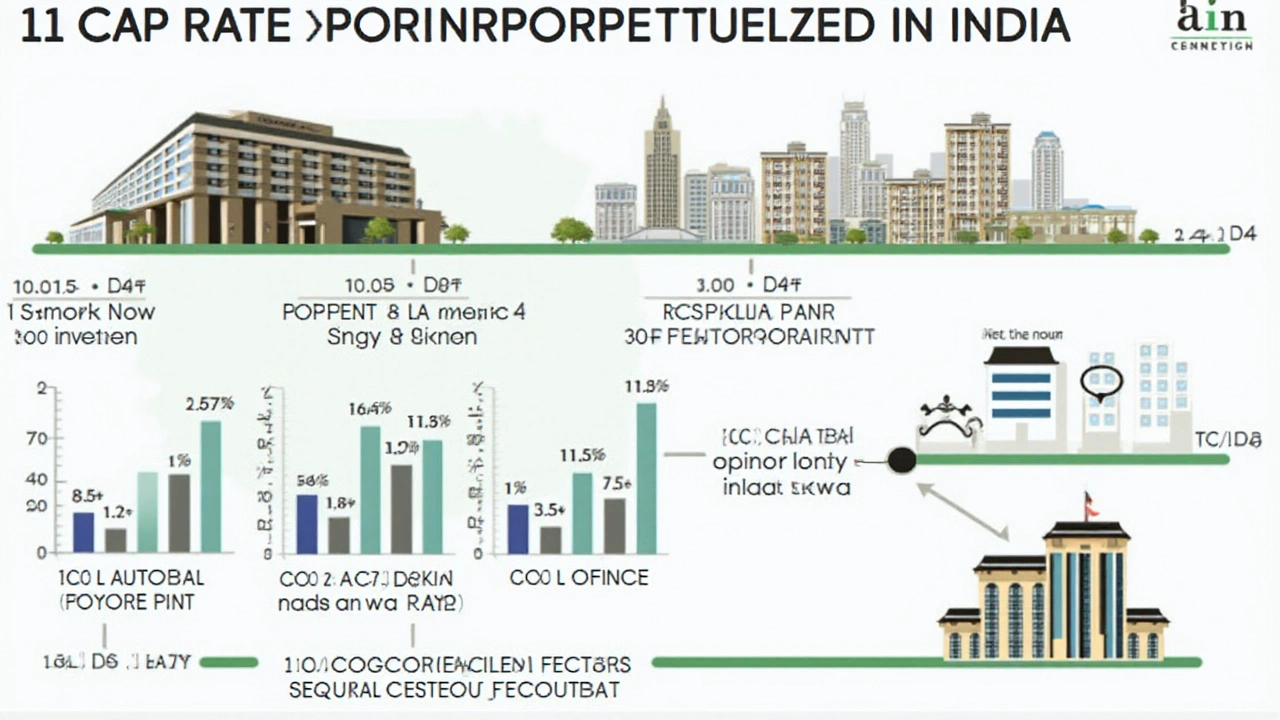When stepping into the realm of commercial real estate, one of the first terms you'll encounter is the cap rate, short for capitalization rate. It's a helpful metric used by investors to evaluate the potential return on a property investment. But what exactly makes a cap rate 'good'?
Think of the cap rate as a snapshot of a property's risk profile and profitability. At its heart, it's the ratio of a property's net operating income to its purchase price, expressed as a percentage. This figure can act as a crystal ball of sorts, forecasting the annual return an investor might expect, minus mortgage costs.
However, while high cap rates can mean lucrative returns, they're not without their own set of risks. Markets fluctuate, locations vary in appeal, and property types each have their quirks. By understanding the ins and outs of cap rates and how they relate to commercial properties, investors can navigate the market more effectively, armed with insight on what a 'good' rate might entail for their specific goals.
- Defining Cap Rate and Its Significance
- Factors Influencing Cap Rates
- Typical Cap Rate Ranges for Different Properties
- The Impact of Location and Market Trends
- How to Calculate and Interpret Cap Rate
- Practical Tips for Investors
Defining Cap Rate and Its Significance
The cap rate is often referred to as the heartbeat of the commercial real estate investment world. It's not just a nebulous figure floating in financial discussions, but a practical, straightforward calculation that provides meaningful metrics to potential investors. At its core, the cap rate is defined as the net operating income (NOI) of a property divided by its current market value or sales price, yielding a percentage that represents an expected annual return on investment. It’s essentially a quick and intuitive way to determine the value of an income-generating property, giving investors immediate insight into potential revenue streams and risk levels.
To delve a bit deeper, consider the cap rate as a mirror that reflects economic health relative to various property types. Whether you're assessing a bustling downtown office building, a suburban strip mall, or a sprawling warehouse, the cap rate can illuminate aspects of investment performance and viability. It serves as a tool for comparing different investments and gauging the likelihood of achieving financial objectives. The allure of cap rates lies in their simplicity and versatility. They allow even novice investors to categorize real estate markets and opportunities, comparing local versus national averages through a basic calculation.
A useful way to appreciate its utility is by considering a quote from industry leader Robert Kiyosaki, who once said, "Real estate investing, even on a very small scale, remains a tried and true means of building an individual's cash flow and wealth." This quote encapsulates the promise of real estate—and by extension, the cap rate—as a reliable gauge to attain financial growth, creating a pathway for informed decision-making. While the cap rate itself might be straightforward, interpreting it requires a nuanced understanding of various market dynamics and investor strategies. As an investor, the cap rate helps you evaluate not just the profitability but the inherent challenges of particular markets or property segments. When the right balance is struck, it can become a cornerstone of a successful investment portfolio.
In terms of practical application, different property sectors often have differing cap rate norms, influenced by market demand, location desirability, and economic cycles. For instance, prime commercial real estate in high-demand urban centers may exhibit lower cap rates, indicating lower risk but steadier returns. Conversely, a higher cap rate might reflect greater risk, typical in developing or transitioning markets, but also suggests the potential for higher rewards should conditions favor growth. Thus, knowing and understanding this can puzzle out the best real estate choices.
The calculation of cap rates remains foundational to property evaluation for a reason; despite its simplicity, the depth of analysis it enables makes it an irreplaceable tool. Economic shifts, supply and demand balance, and evolving tenant preferences all contribute to shifting cap rates, and staying on top of these changes is crucial for intelligent investing. By understanding its significance and calculating it accurately, investors can mitigate risks while capitalizing on lucrative opportunities in the real estate sector, securing their path to stable financial futures.
To summarize, cap rates are more than just numbers—they are an investor’s guide into understanding market climates, potential returns, and underlying risks. This is where the importance of grasping the cap rate becomes clear, offering a gateway to making informed, strategic decisions that enhance and preserve real estate investments over the long haul. Through its application, one can better seize opportunities as they arise, leveraging data-driven insights for profitable outcomes.
Factors Influencing Cap Rates
Delving into the world of commercial real estate, one quickly discovers that a cap rate isn't purely a percentage to be ticked off a checklist. It's a dynamic figure, shaped and molded by multiple factors that whisper stories of market sentiments, economic climates, and investment risks. The most significant of these factors is the type of property. Whether one is investing in retail, office spaces, industrial settings, or multifamily units, each comes with its distinct cost and income expectations. Retail properties, for example, often experience fluctuations in cap rates influenced by consumer trends and the health of the retail sector at large. In contrast, multifamily units might present more stable cap rates due to constant housing demand.
Location is another powerful influence over cap rates. A property situated in a high-demand area with an economic boom, like a city center or a thriving tech hub, will likely boast lower cap rates. This low rate indicates more investors vying for a stake, anticipating less risk and a steady income. On the other hand, properties in less desirable or economically stagnant areas might exhibit higher cap rates, reflecting the higher risk involved and possibly larger returns, should conditions improve. The balance between risk and reward plays a critical role here. Investors weigh these options meticulously, deciding whether to chase potentially high returns with greater risk or to settle on lower-risk, stable investments with lower cap rates.
Economic conditions cannot be ignored when assessing cap rates. Inflation, interest rates, and broader economic health directly affect financing costs and property values. High interest rates, for instance, can lead to higher cap rates as borrowing becomes more expensive, forcing sellers to adjust prices to attract buyers. Conversely, a low interest environment tends to reduce cap rates as cheaper money makes real estate more competitive. As economies shift, so too do investor expectations and the cap rates they find acceptable. In times like these, understanding economic indicators and their implications can give investors a significant edge.
Interestingly, supply and demand dynamics also dictate cap rates in quite a direct manner. Using the basic economic principle, an increase in demand with limited supply can drive cap rates down. Cities undergoing rapid expansion or redevelopment often witness changing cap environments, as new developments alter the supply landscape, adjusting competition and inherently modifying potential returns. It's intriguing how these macro and microeconomic factors intertwine to paint a comprehensive picture that investors must analyze and interpret.
Regulatory aspects, including zoning laws and tax incentives, further steer cap rate shifts. Favorable zoning regulations, offering flexibility for redevelopment, elevate a property’s investment appeal and often bring cap rates down. Similarly, tax incentives provided for developing environmentally friendly buildings or restoring historical structures can sweeten the deal, allowing investors to accept lower cap rates in exchange for longer-term financial benefits.
Lastly, yet importantly, investor sentiment and market psychology can’t be underestimated. Market trends, propelled by wider economic narratives or sector-specific developments, tap into herd mentalities, pushing cap rates up or down based solely on perception. This speculative aspect can be best captured in the words of real estate magnate Sam Zell:
“Investment property is all about perception. You’re buying streams of income expected, and therefore, perception is everything and affects the return you can expect.”This delicate balance of tangible and intangible influencers makes the world of commercial real estate cap rates both fascinating and challenging, demanding skilled analysis and nimble decision-making.

Typical Cap Rate Ranges for Different Properties
Delving into the intricacies of commercial real estate, the cap rate—a metric that quantifies the return on investment properties—varies significantly across different property types. These variations stem from inherent risk factors, projected income streams, and market expectations, which shape the financial landscape associated with each type of commercial real estate. Typically, multi-family residential properties, often considered as stable performers, exhibit cap rates ranging from 4% to 10%. These properties benefit from consistent rental income, which attracts risk-averse investors seeking reliability over gigantic returns.
Conversely, office spaces command diverse cap rates, generally falling between 5% and 12%. This variance is influenced by factors such as the location, tenant reliability, and contract length. An office building nestled in the heart of a bustling CBD may present a lower cap rate, reflecting reduced risk and steady demand, compared to the same building in a less attractive location. A 2023 market report by JLL reiterated this trend, emphasizing the importance of tenant diversity in stabilizing returns in global metropolis environments.
Retail spaces, synonymous with fluctuation, demand careful consideration. Before the pandemic, retail properties frequently showcased cap rates between 5% and 10%. Post-pandemic trends, however, have altered the landscape, with many areas experiencing shifts towards e-commerce. This evolution is highlighted in an article by Real Estate Weekly, where Marcus & Millichap noted that "The pandemic has sculpted new investor strategies, forcing shifts in traditional retail valuations and expectations." The volatility and adaptation required in retail underline the larger cap rate swings now noted across markets.
Industrial properties, often the darlings of recent investment waves, present cap rates generally within the 6% to 12% range. The fascination with logistics and warehousing is primarily driven by e-commerce growth and supply chain reconfigurations, offering appealing returns to investors riding this wave. An interesting study by CBRE pointed out that industrial properties in key logistic hubs consistently outperform in terms of low vacancy rates and stable returns. Their analysis indicates an upward trend in investor interest, pushing cap rates to narrower bands among competitive locales.
Lastly, hospitality properties offer cap rates presenting both high risks and potentially high rewards. Enticingly high, cap rates for hotels can frequently cross the 10% mark, a nod to the sector's susceptibility to economic dips and consumer trends. The requirement for adept management and strategic location selection is crucial to navigating and thriving in this domain. As the sector rebounds with global tourism revival, investors anticipate future opportunity windows amid acknowledged risk visibility.
In essence, understanding cap rate nuances across property types is crucial. This helps investors to clearly chart paths that harmonize with their risk appetite and business strategies. By considering these typological frameworks and market dynamics, stakeholders position themselves effectively to leverage investment opportunities across the diversified commercial real estate spectrum.
The Impact of Location and Market Trends
When diving into the myriad factors that influence cap rates, you can't overlook the powerful effects of location and market trends. These elements are often the kingmakers in determining whether a real estate venture flounders or flourishes. To put it simply, a property nestled in a bustling urban metropolis can command vastly different rates than one perched in a sleepy suburb. Urban areas, with their constant hum of activity, create a dynamic environment where demand often sways cap rates. Locations tethered to thriving industries, vibrant cultural scenes, or robust transportation links tend to have lower cap rates due to perceived lower risk. In contrast, rural locales or regions with waning industries might allure investors with higher cap rates but bring along elevated risks.
Market trends add yet another layer of complexity to the calculus. In recent years, shifts towards remote work have altered the landscape of demand, particularly for commercial spaces like office buildings. While once high in demand, many urban offices have seen shifts in their valuation, impacting their commercial real estate cap rates. Economic cycles, interest rate fluctuations, and demographic changes all breathe life into shifting trends. For instance, areas experiencing a population boom often become hotbeds for investments due to expected growth in demand for commercial spaces, thus affecting their cap rates. Meanwhile, seasonal trends in tourism-driven markets can also play a significant role, driving cap rates down during peak seasons and adjusting as the flow of tourists ebbs.
Investors must stay attuned to these market ripples. Tracking emerging trends in consumer behavior, technological advancements, and economic forecasts can provide a lens into future shifts in cap rates. A smart investor knows that a keen eye on these trends is not just beneficial—it’s essential. As real estate mogul Sam Zell once said,
"Risk is the investor's choice, but understanding the risks is what separates wealth from woes."To get ahead, it's critical to analyze how local economies are evolving, consider upcoming infrastructure projects, and be mindful of environmental factors that could sway demand in unpredictable ways.
Investors looking to harness this knowledge should prioritize data-driven decisions. A close examination of historical data can shed light on how past trends have influenced property sale values. For instance, analyzing a table of past cap rates juxtaposed with key market events might reveal insightful patterns and foresee potential market trajectory changes. Additionally, leveraging modern tools such as geographic information systems (GIS) for spatial analysis of location-based data can refine the decision-making process. Understanding the intricacies of location coupled with market trends empowers investors to not only discern the current market disposition but also to anticipate future shifts, providing them a strategic edge in the ever-evolving real estate arena.

How to Calculate and Interpret Cap Rate
Calculating the cap rate isn't rocket science, but it can certainly feel like you're juggling numbers in a circus of possibilities. At its core, the cap rate is the ratio of a property's net operating income (NOI) to its purchase price. To break it down, the formula goes something like this: take your NOI, which is essentially your revenue from the property minus the operating costs, then divide it by the property’s current market value or purchase price. The result, multiplied by 100, gives you the cap rate expressed in percentage form. This percentage is your beacon, guiding investors towards understanding the potential return the property can offer in relation to its price.
Diving into an example helps clarify this: imagine a commercial property with an annual NOI of $100,000. If the asking price for this property is $1,000,000, the calculation would yield a cap rate of 10%. This figure acts as your preliminary insight into whether the investment aligns with your risk appetite and goals. But interpreting this number involves more nuance. High cap rates may suggest greater returns but they also indicate higher risk and potentially more volatile income streams. On the flip side, low cap rates typically reflect a steadier, albeit lesser, expected return, often associated with properties in prime locations or sectors considered reliable.
Understanding these layers is crucial. Market conditions and property characteristics should be weighed along with cap rates to make sound decisions. As a rule of thumb, a balanced approach considers not just the cap rate, but factors like vacancy rates, local economic indicators, and potential for rent increases. Remember, these figures can be manipulated by the assumptions you make on expenses and projected income. So it’s critical to dig deeper and recognize that a good cap rate is about more than just a number.
Further Insights and Applications
A fascinating example of practicality lies in a study done by CBRE, which showed that properties in bustling metropolitan areas often reflect cap rates as low as 3% to 5%. The rationale? The areas' low risk environment driven by demand stability and economic buoyancy. Contrast this with properties in emerging neighborhoods where cap rates might range from 8% to 12%, attracting investors willing to speculate on future prosperity. Thus, the lower the risk perceived, the lower the cap rate applies. Quite compelling, isn't it?For budding investors wondering how other investors handle these variables, consider insights from renowned investor Sam Zell, who once remarked,
"It's not the return on my money that worries me, it’s the return of my money."This perspective underlines the importance of balancing risk and reward in any real estate venture. While the cap rate might not paint the full portrait, it’s an indispensable tool in the investor's toolkit, helping to measure immediate yields against potential long-term gains.
Practical Tips for Investors
For anyone dipping their toes into the vast waters of commercial real estate, understanding how to leverage cap rates can be a game-changer. A solid grasp of what these percentages signify is only half the battle—applying this knowledge in practice is where the real value lies. First up, diversification should be at the forefront of any investment strategy. Just as with stock portfolios, spreading investments across different property types and locations can mitigate risk. A mix might include office spaces in bustling city centers, retail hubs in suburban areas, and industrial sites on the outskirts.
"Real estate investing, even on a very small scale, remains a tried and true means of building an individual's cash flow and wealth," says Robert Kiyosaki, famed entrepreneur and author.
The next consideration is understanding the market cycle and economic indicators. Interest rates, employment figures, and consumer confidence all influence cap rates. During periods of economic growth, cap rates might lower due to increased property values—meaning investors might have to accept lower initial returns, but these properties often offer more stable, long-term revenue. Contrastingly, during downturns, higher cap rates can signal discounted opportunities, though these might carry higher risks. Thus, vigilant monitoring of these external factors can greatly assist in timing your purchases.
Another strategic tip is mastering the art of negotiation and financing. Securing favorable loan terms can significantly enhance the attractiveness of a property on paper, elevating your cash flow potential. This might involve shopping around for lenders who offer competitive rates or even re-negotiating terms with existing mortgage providers. Always remember that while a high-interest loan might allow for immediate entry into the market, it could diminish the value of your investment over time.
Being a successful property investor often requires a flexible mindset. While long-term holdings are a common goal, being open to selling when a property’s cap rate no longer aligns with market benchmarks can be prudent. There’s merit in occasionally liquidating assets for re-investment into higher-yielding opportunities or emerging markets, where cap rates offer appealing returns. This adaptability ensures continued growth in your investment portfolio and safeguards against market shifts.
Finally, tapping into technology and data analytics can offer unprecedented insights. Tools that provide real-time property valuations, trend analysis, and predictive modelling can be invaluable. These technologies can reveal potential cap rate trends before they’re apparent to the market at large, giving savvy investors a competitive edge. Plus, leveraging platforms that streamline property management processes can save time and reduce operating costs, thereby indirectly boosting your property's net income and the calculated cap rate. Remember, in the digital age, data is almost as indispensable as location in real estate success.





